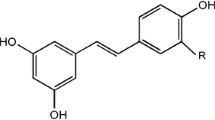Abstract
During manufacture of plywood from yellow meranti (Shorea spp.) collected in Sarawak, the extractives stick on press boards and on plywood panels in some cases. The stuck material is phenolic and has low solubility in organic and inorganic solvents. Investigation of the methanol extracts of yellow meranti wood suggested that the material is a mixture of biosynthetic compounds and/or their secondary oxidative polymers of resveratrol and its related stilbenes.
Zusammenfassung
Während der Sperrholzproduktion aus Meranti bleiben Extraktstoffe manchmal auf der Presse und den Platten kleben. Das anhaftende Material ist phenolischer Natur und nur wenig in organischen und anorganischen Lösemitteln löslich. Untersuchungen des Methanolextraktes von Merantiholz ergaben Hinweise darauf, daß es sich dabei um Biosynthesprodukte handelt und/oder deren sekundär oxidierte Polymere abgeleitet von Resveratrol und verwandten Stilbenen.
Similar content being viewed by others
References
Bokel M, Diyasena MNC, Gunatilaka AAL, Kraus W, Sotheeswaran S (1988) Canaliculatol, an antifungal resveratrol trimer fromStemonoporous canaliculatus, Phytochem., 27: 377–380
Coggon P, Janes NF, King FE, King TJ, Molyneux RJ, Morgan JWW, Sellars K (1965) Hopeaphenol, an extractive of the heartwoood ofHopea odorata andBalanocarpus heimii. J. Chem. Soc., 1965: 406–409
Coggon P, King TJ, Wailwork SC (1966) The structure of hopeaphenol. J. Chem. Soc. Chem. Commun., 1966: 439–440
Geevananda YA, Gunawardana P, Uvais M, Sultanbawa S, Balasubramaniam S (1980) Distribution of some tritepenes and phenolic compounds in the extractives of endemic Dipterocarpaceae species of Srilanka. Phytochem., 19: 1099–1102
Madhav R, Seshadri TR, Subramanian GBV (1967) Identity of the polyphenol ofShorea species with hopeaphenol. Phytochem., 6: 1155–1156
Pryce RJ, Langcake P (1977)α-Viniferin, an antifungal resveratrol trimer from grapeviens. Phytochem.,16: 1452–1454
Samaraweera U, Sotheeswaran S, Sultanbawa MUS (1982) Polyphenols from Stemonoporus species. Phytochem., 10: 2585–2587
Sotheeswaran S, Sultanbawa MUS, Surendrakumar S, Bladon P (1983) Polyphenols form Dipterocarp species. Copalliferol A and stemonoporol. J. Chem. Soc. Perkin trans. I. 1983: 699–702
Sotheeswaran S, Sultanbawa MUS, Surendrkumar S, Balasubramanian S, Bladon P (1985) Polyphenols from Dipterocarp species. Vaticaffinol andɛ-viniferin. J. Chem. Soc. Perkin Trans. I. 1985: 159–162
Yasuda S, Niwa J, Terashima N, Ota K, Tachi M (1986) Inhibitory component of manngashinoro wood in cement hardening. Mokuzai Gakkaishi, 32: 748–751
Author information
Authors and Affiliations
Rights and permissions
About this article
Cite this article
Yasuda, S., Imai, T., Fukushima, K. et al. Effect of the extractives of yellow meranti wood on the manufacture of plywood. Holz als Roh-und Werkstoff 56, 87–89 (1998). https://doi.org/10.1007/s001070050271
Issue Date:
DOI: https://doi.org/10.1007/s001070050271




